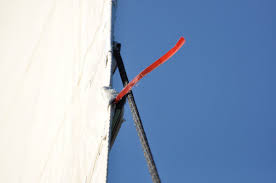A flow is the movement of a fluid. A streamline is the materialization of the movement of the fluid in a flow.
There are 2 types of flows:
- Laminar: the current lines are almost parallel to each other.
- Vortex: the current lines are totally disordered.
The sails of a sports dinghy are most effective when the flow is laminar. It is highlighted by the penons and favors.

Penons

Favors
The flow remains laminar up to about 40 degrees of incidence, i.e. a broad reach / wide reach gait (depending on the speed of the dinghy).
Downwind, the flow is turbulent. The state of the flow depends on several factors: viscosity of the fluid ( \(V\) ), speed of the flow, density ( \(p\) ) of the fluid. In order to understand how the forces that drive our drifter are formed, let’s look at the different pressures along the flows.
The total pressure of a moving fluid is the sum of:
- Its static pressure ( \(Ps\) ): for the case of air, this is the meteorological pressure.
- Its dynamic pressure ( \(Pd\) ): which depends on its velocity squared \(Pd = 1/2 ρV2\)
Bernoulli states that within an incompressible flow, the total pressure remains constant along a streamline : \(V^2/2 + Ps/P = cste \)
Laminar flow generating displacement #
What we are interested in is understanding how a sail, immersed in a flow (the speed of the boat), can move the boat forward.

Sail lift
The sail surface (curve) deflects the flow. From a certain distance, the flow is no longer disturbed.
On the upper surface there is a tightening while on the lower surface there is a widening. This is a Venturi effect: the air is accelerated on the top surface while it is slowed down on the bottom surface (case of a “simple” sail).
There is therefore a decrease in static pressure on the top surface and vice versa on the bottom surface.
The static pressure differential creates a force: the aerodynamic force or buoyancy. The suction (top surface) is more important than the thrust (bottom surface).
Profile stall #
In a normal situation, the airflow is “attached” to both sides of the wing, top and bottom. The airflow sticks to the airfoil, which favors the lift.
At a certain angle of incidence, about 15 to 20°, depending on the characteristics of the wing - profile, aspect ratio, etc. - and the number of

Profil normal
display_reading_time: true display_share_buttons: true navigation:
- “/docs/dinghy_mecanic”
- “/docs/dinghy_mecanic/strengths”

Profil décroché
